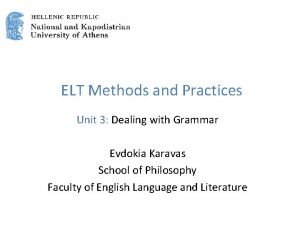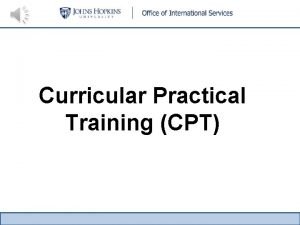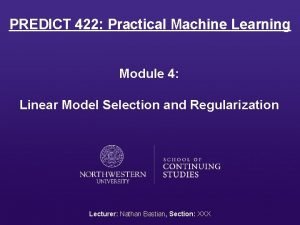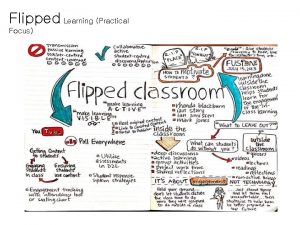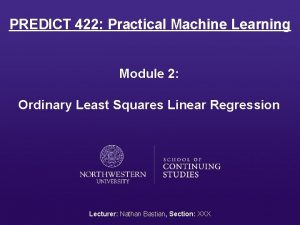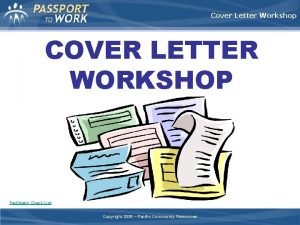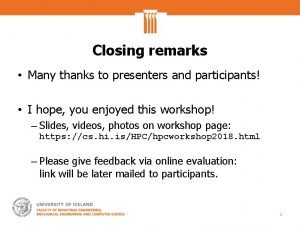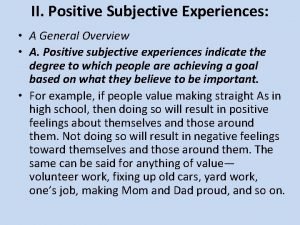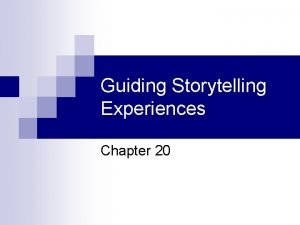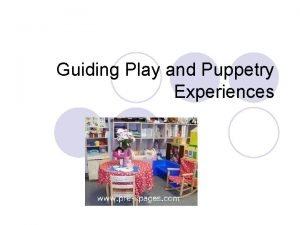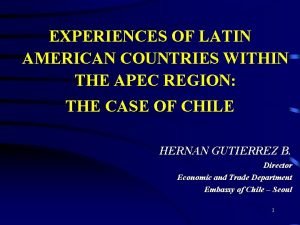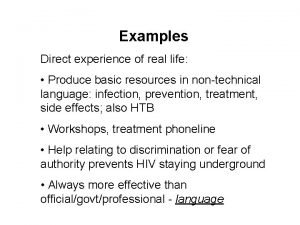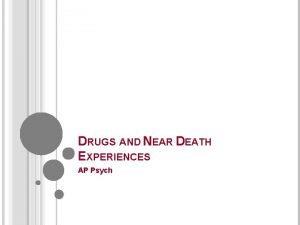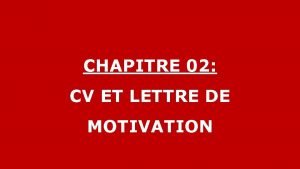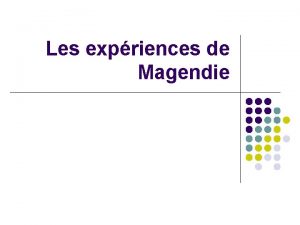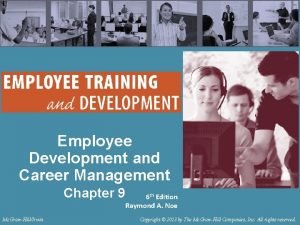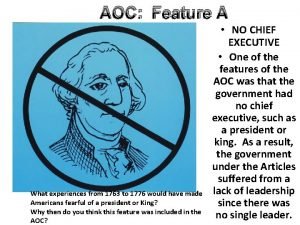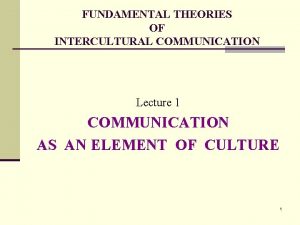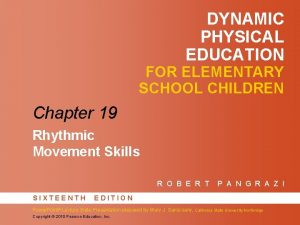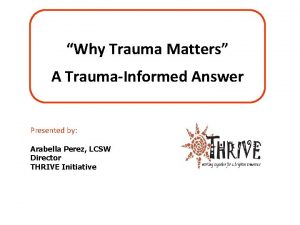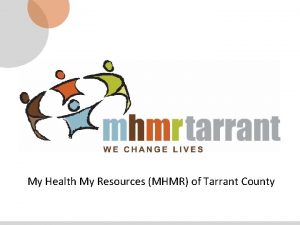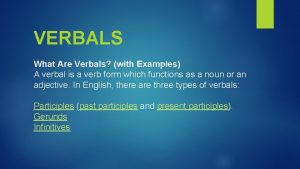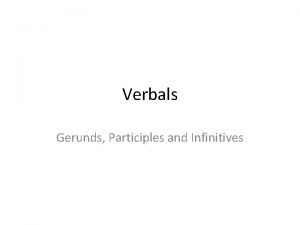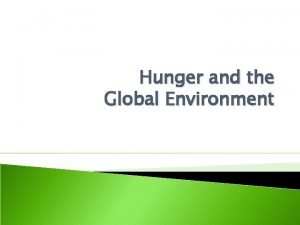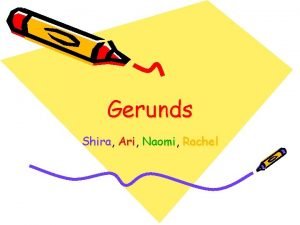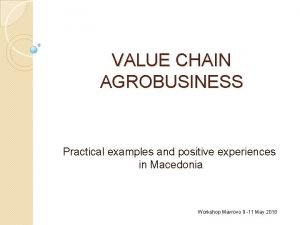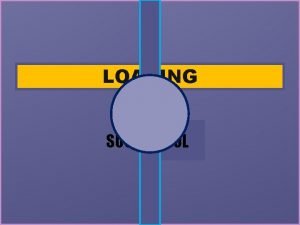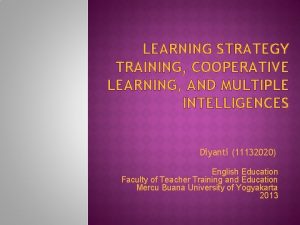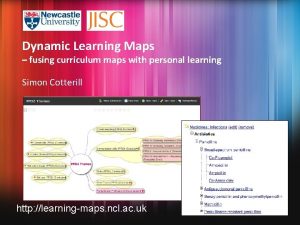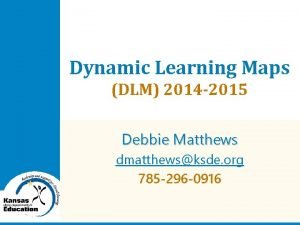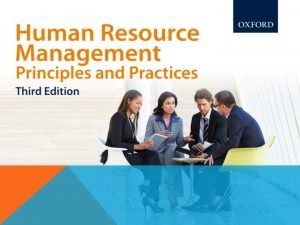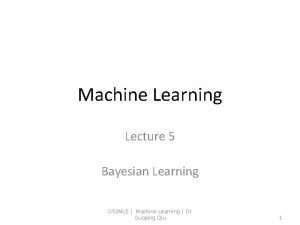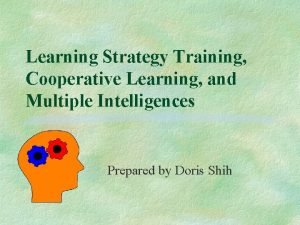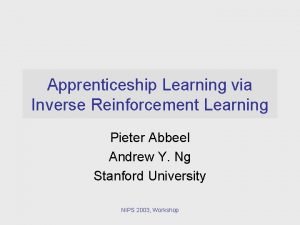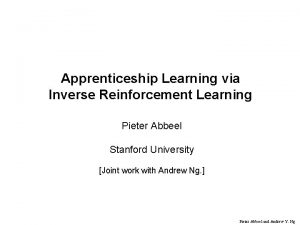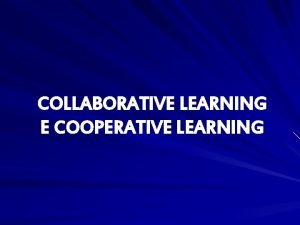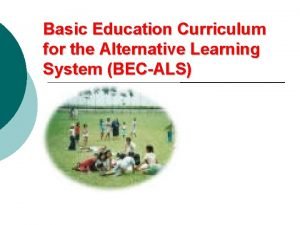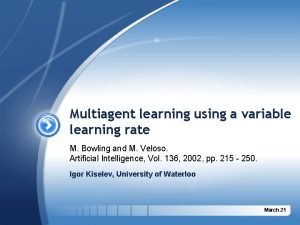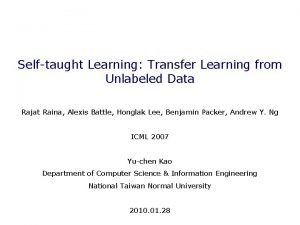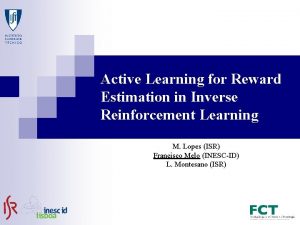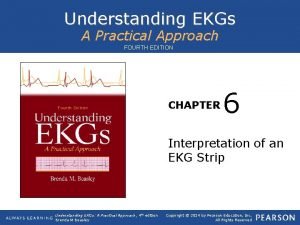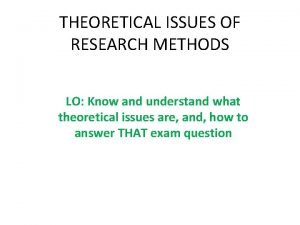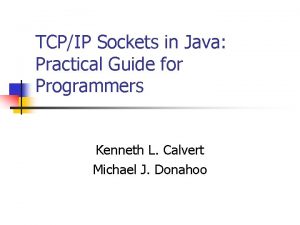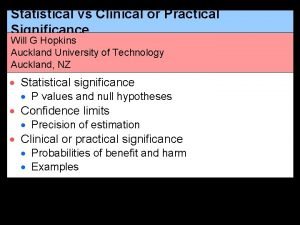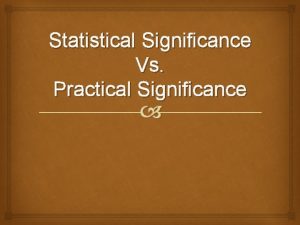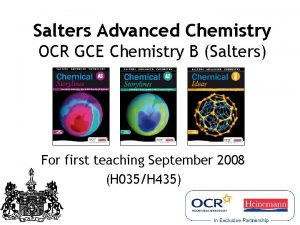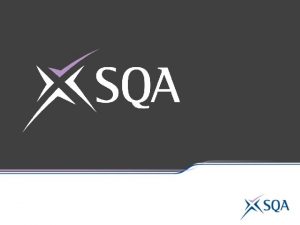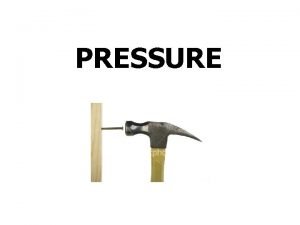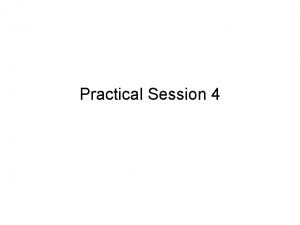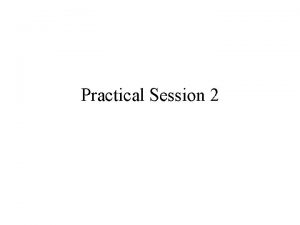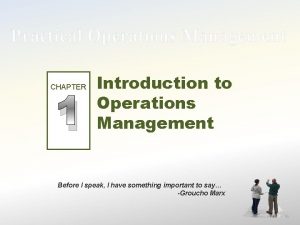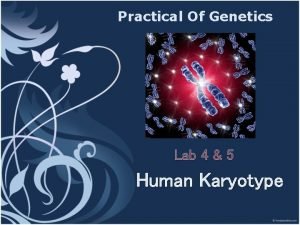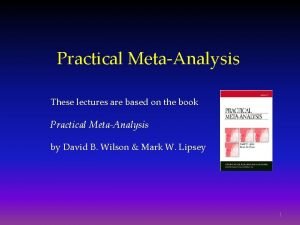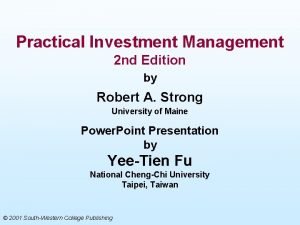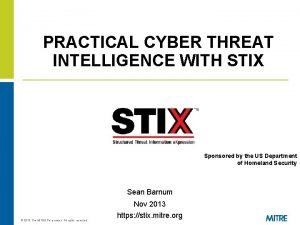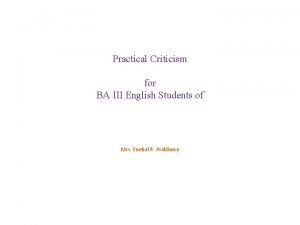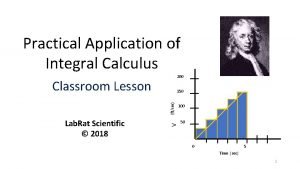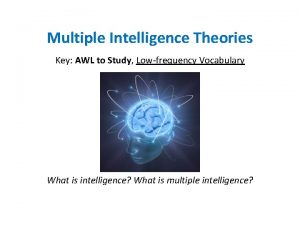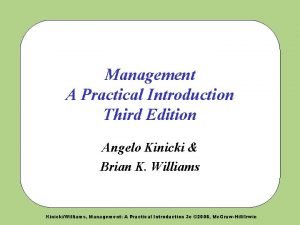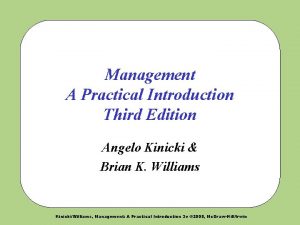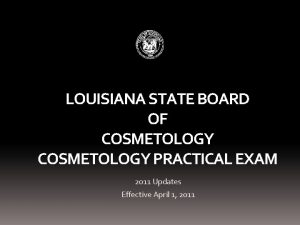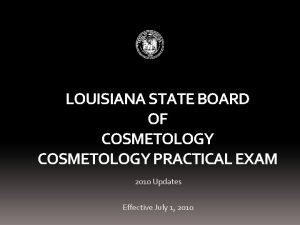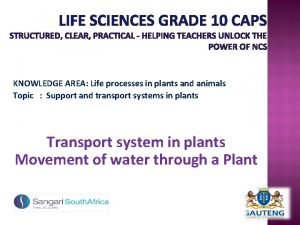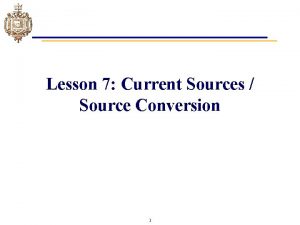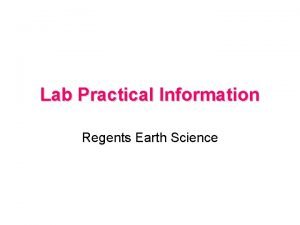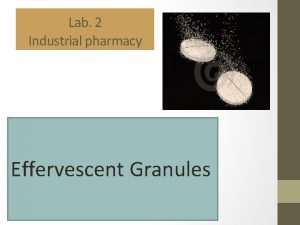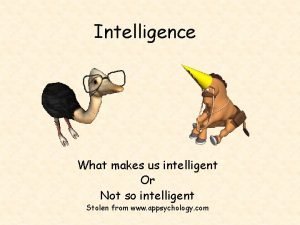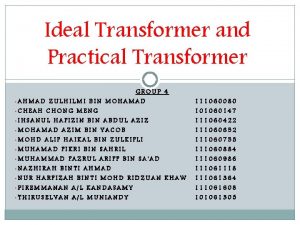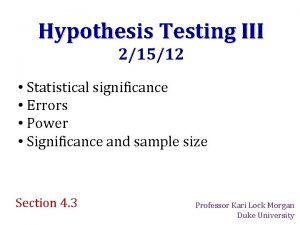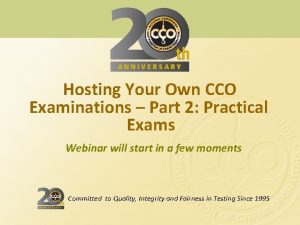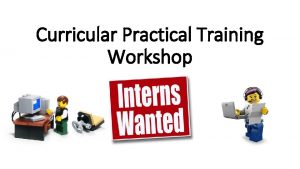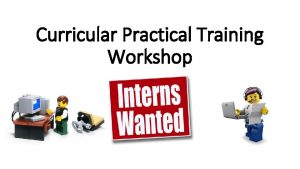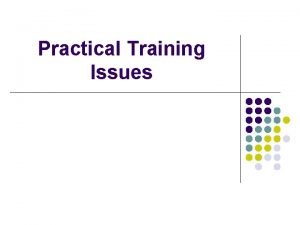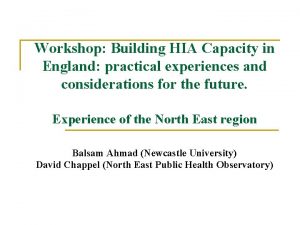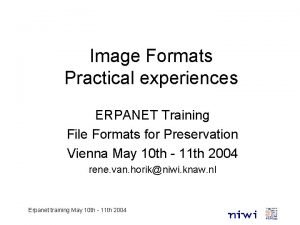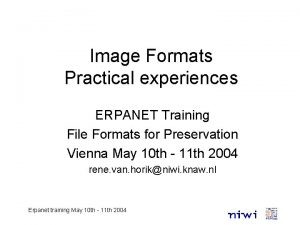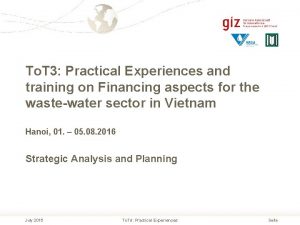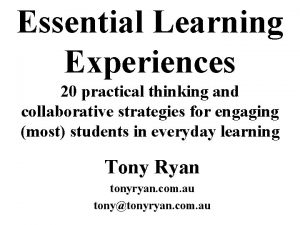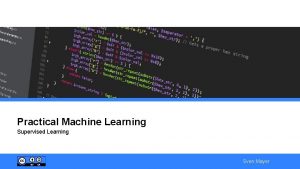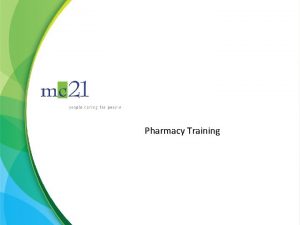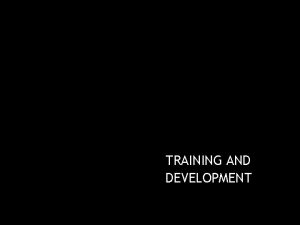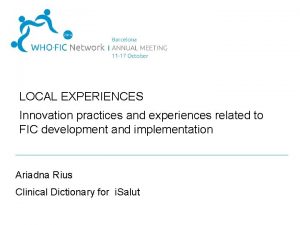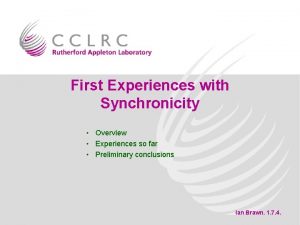Learning from practical experiences FP 7 Training Workshop





























































































































- Slides: 125

“Learning from practical experiences ” FP 7 Training Workshop Leonardo Piccinetti

1 Day Intensive Framework Programme Induction and Training Module 3 Title: ““Project proposal preparation and writing under FP 7” Introduction Pre-screening of project ideas Proposal concept note The Proposal Part A Part B Proposal budget Submission & evaluation Negotiation and kick-off

You should all be familiar with… Call for Proposals Official documentation (work prog. ) Rules for participation International consortium Funding schemes Eligible costs and funding criteria

Sources of information Work programme Guide for applicants + proposal structure Guidelines for evaluators (Financial guidelines) + Other sources on topic

Rules for participation 3 partners from 3 different MS/AS is a formal minimum Consortium composition must depend on: Necessity/complementarity Excellence Common project vision (no “friends”)

Funding Schemes – recap “Types of projects” Funding Scheme Typical characteristics Size Large CP – IP Integrated approach 20+ partners, 15 M€, 5 -10 years Small-Med CP – STREP Specific research project approach 5 -6 partners, 3 M€ funding, 3 -5 years CSA – Supporting Supports European R&D activities 5 -10 partners, 1 M€ funding, 1 -2 years CSA – Coordinates ongoing European R&D activities 5 -10 partners, 1 M€ funding, 1 -2 years SME measures – CRAFT Specific research project with SME component 5 -10 partners, 1 -2 M€, 2 -3 years

Funding rates - Recap Funding scheme CP Gen rule Public, Uni, SME OH 50% 75% RIC/Flat rates (20%-60%) 100% 7% CSA

Project Idea Consistent with the call and the workprogram !! Innovative ! European dimension (think what interests Europe, not what interests you)! Check Cordis/web for already similar funded proposals Why bother? Which problem is solving? Is it important? Why do R&D and not buy a ready product or know-how? Why now ?

Index Introduction Pre-screening of project ideas Proposal concept note The Proposal Part A Part B Proposal budget Submission & evaluation Negotiation and kick-off

Pre-screening of project ideas Proposal writing is expensive, time consuming and risky Pre-screening allows early (cheap) assessment of an idea Viability of idea in terms of: 1. Relevance to Programme/Topic 2. Innovativeness 3. Funding scheme Can the proposal be submitted?

Innovativeness of the project idea should be considered worldwide. Investigation should be carried out at the following levels: State of the art at European Level State of the art outside Europe (mainly in US, Japan, Canada) FP 5/FP 6 projects CORDIS website

Relevance Work-plan Match the project idea with the expectation of EC and to evaluate the relevance of the idea with the current work programme Expected outcome of the project idea and the activities foreseen Identify (verify) the instruments to be used to implement the proposal The evaluation criteria To have a preliminary match with the expectation of EC in term of impact, relevance, and quality of the project idea

Match the project idea with Calls and Instruments The specific topics described in the Work. Programme + check other Themes, too! The instruments to be used: STREP vs. IP Consider that to implement and to manage small or medium-scale focused research actions is different from large-scale integrating projects The call when the proposal can be submitted

How to perform a pre-screening 2 approaches Scientific approach: From scientific idea to work programme Practical approach: From the work programme to scientific idea P Ideal approach Pre-screening processes will be different according to the approach chosen

Outcome of pre-screening Preliminary evaluation of the Innovativeness of the project idea; Preliminary evaluation of eligibility and relevance of the project idea; Identification of specific topic/priority relevant for the project idea; Identification of the call and deadline to submit the proposal; Identification of the instruments to be used to implement the project idea GO / NO-GO ?

Build the consortium choose the right partners … Prepare a proposal abstract (1 page maximum). Don’t need and should not be extensive. Don’t disclose critical information. Design your consortium in line with project objectives. If applicable, Choose an enthusiastic experienced co-ordinator, who has appropriate time and resources available! Choose partners motivated and committed to deliver Build a credible well balanced consortium - complementarity! Consider the geographical spread, expertise, type (eg SME) Check the reputation and resources of your partners! Consider the language barrier and cultural differences! Choose partners you would like to work with for years Develop mutual trust! Don´t involve your direct competitor(s)!

Build the consortium/ Find partners check your own existing international contacts: business & academic contacts, conferences, fairs use bilateral agreements draw on the contacts of colleagues use the networks of NCPs, IRCs, . . . use the Internet, CORDIS Partners/Projects, Eo. I attend Information Days, Brokerage Events, etc. ensure that foreign colleagues can contact you: e. g. develop your profile, Internet homepage, . . .

Index Introduction Pre-screening of project ideas Proposal concept note The Proposal Part A Part B Proposal budget Submission & evaluation Negotiation and kick-off

From the Idea to the Proposal 1. 2. 3. 4. 5. 6. Identification of main project objectives/outcomes; Definition of main activities; Identification of necessary partners and expertise; Quantification of the resources needed (in terms of effort, equipment, etc. ) Illustrate project flow in a diagram (PERT) Develop the first CONCEPT NOTE

Project concept note Summarises key elements of proposal Vision statement and state-of-art Main (broad) objectives Partners and expertise sought First breakdown of activities Addressed call and indicative project budget Flexible proposal structure used to involve new partner and double check idea Ò Never go ahead with writing a proposal without a prescreening and concept note!

Project concept note (2)

Introduction to proposal writing One leader is responsible for writing the proposal and consolidating all contributions Common idea of objectives and outcomes Make clear writing plan and assign responsibilities to partners Know documentation well (work programme, guide for applicant, guide for evaluators, etc. ) Use the right templates described in Guides for applicants Submission: familiarise with EPSS in advance Quality check mandatory for ALL contributions Produce a professional and consistent document

We General are Timeline here From idea to contract Project idea – decision on the main research/ business reasons -20 for undertaking the work Official publication of Call for Proposals -12 Abstract of project in accordance with Strategic Objectives -11 -10 Search for partners Break down of work - discussions -8 -6 Writing of proposal by coordinator – approval by partners -3 Submission of proposal -1 Forming of Consortium Deadline Time 0 (weeks) Evaluation by external experts-Project retained for negotiation +6 Overall evaluation report to Programme Committee +12 Evaluation Summary Reports to coordinator +13 Contract negotiations between Project Officers and coordinator +22 Project approved, signature of contract and entry into force +24 Project start +26 +30 Initial payment to coordinator within 60 days of signature

Index Introduction Pre-screening of project ideas Proposal concept note The Proposal Part A Part B Proposal budget Submission & evaluation Negotiation and kick-off

Proposal Writing (1) Keep in mind evaluators are from industry, universities, nonuniversity research organisations, others (diverse profiles) first, 3 to 6 evaluators evaluate each proposal individually, then they prepare a summary report, the evaluators are in seclusion for several days under "spartan" conditions. . . they have to evaluate 3 -5 proposals per day the evaluators may not be the ultimate experts in the field of your proposal. . . Keep it clear and simple without loosing quality

Proposal Writing (2) Keep in mind a strong title, acronym an interesting project summary (objectives, results, R&Dapproach, partnership, utility of results, exploitation) convincing techn. background and state of the art clear objectives, methods, results and deliverables well designed work plan (work packages, milestones, deliverables; diagrams; Gantt & PERT diagram) appropriate management structures & procedures (project steering and control, decision making, technical management, implementation management, . . . ) implementation & exploitation of results, users! realistic costs that lie within the budget of the Call convincing consortium (roles, qualifications)

Proposal Writing Plan Appoint proposal writer Write a 1 -2 page proposal Circulate for comment s Consortium meeting if necessary (distribution of work) Workpackag es managemen t Exploitation, etc. Compile proposal Submit proposal Review by “experts”

Proposal Writing Plan appoint writer Appoint proposal writer Many people and partners will be involved in the proposal writing and will proposal contribute with material but Appoint only one should have writer the overall responsibility Circulateand: vcheck Write a 1 -2 page proposal conformity proposal and for consistency comment s vmake necessary adjustments Consortium meeting if necessary vsubmit the proposal (distribution of work) And… Workpackag es managemen t Exploitation, etc. vloose his sleep over the proposal Compile proposal Submit proposal Review by “experts”

FP 7 Proposal NB: Proposal structure depends on the funding scheme (instrument), sections are not always exactly the same PART A Formal & Admin Info PART B Technical content of proposal

Proposal outline Part A: FORMS A 1: General info on proposal (1 per proposal) A 2: Info on the coordinator and the other partners (1 per partner) A 3: Cost breakdown (1 per partner) Part B: CONTENT Cover page & abstract Section 1: S&T quality and relevance to Call Concept & objectives Progress beyond the state-of-the-art S/T Methodology and work plan WP descriptions + tables and charts Section 2: Implementation Management structure and procedures Individual participants Consortium as a whole Resources to be committed Section 3: Impact Expected impacts listed in the work programme Dissemination and exploitation of project results and IPR management Section 4: Ethical issues Section 5: Consideration of gender aspects

Parts – Content of a proposal Part A: FORMS A 1: General info on proposal (Title, abstract, keywords, etc. ) A 2: Info on the coordinator and the other partners (one form per partner) A 3: Cost breakdown (one sheet for the whole consortium; one line per partner with information on costs and funding requests per activity • Part B: CONTENT – Front page – Contents page – proposal summary – project description

Index Introduction Pre-screening of project ideas Proposal concept note The Proposal Part A Part B Proposal budget Submission & evaluation Negotiation and kick-off

PART A Administrative and formal info — A 1: Summary ü Acronym and title, Duration, addressed Call, Activity Code, ABSTRACT — A 2: Participants’ info ü Legal name and short name, contact info, Non-profit / Public / Research org. , NACE, SME, Dependencies, contact person + info — A 3: Budget ü Requested Community funding, method for calculating OH, budget split per Activity Type, etc.

A 1

A 2. 1

A 2. 2

A 3. 1

Index Introduction Pre-screening of project ideas Proposal concept note The Proposal Part A Part B Proposal budget Submission & evaluation Negotiation and kick-off

Proposal Writing Plan Appoint proposal writer Write a 1 -2 page proposal Circulate for comment s Consortium meeting if necessary (distribution of work) Workpackag es managemen t Exploitation, etc. Compile proposal Submit proposal Review by “experts”

Proposal Writing: Title, Acronym Select a Self-Explanatory but also Nice & Catchy proposal Title & proposal Acronym ! Examples of proposal acronyms: • NEA-TASHA: Novel Evolutionary and Agent-based – Techniques for Automated Safety and Hazard Analysis • ADAM: Adaptation And Mitigation Strategies: Supporting European climate policy • ALARM: Assessing LArge-scale environmental Risks with tested Methods • AMEDEUS: Accelerate MEmbrane DEvelopment for Urban Sewage purification

PART B Content of the proposal Template given in Annex to Guide for applicants – stick to it! Stay within the indicated maximum length per section Where no max: keep your text clear and concise Say important things.

Structure of a Proposal Title and Contents page + Summary Scientific and Technical Objectives Innovation (above the state of the art) Project Work plan and Methodology Deliverables Table Contribution to Objectives Dissemination and Exploitation of Results Project Management Consortium + Partners Roles and Background

PART B Section 1: S/T quality and relevance (1) 1. 1 Concept and objectives Information to be included in this section: general purpose of the project and vision statement organic description of activities to be carried out (phases of the project) specification of scientific and technical objectives of the project definition of expected outcomes for each phase of the project This section is crucial for the evaluation of the quality of the proposal; highlight the scientific basis of the project; describe the connections of the different activities; describe utility of the expected the outcomes and their value in the framework of the project; Suggested length 2 -3 pages

PART B Section 1: S/T quality and relevance (2) 1. 2 Progress beyond the stat-of-the-art Information to be included in this section: Description of the state of the art Identification of main problems, needs, constraints addressed by project; Description of alternative methodologies/tools actually available on the market; Detailed description of the benefit of the proposed methodology/tool in terms efficiency, effectiveness, safety, time consumption, costs, environment, etc. ) Section 1. 2 is linked to the innovative aspects of the proposal; Highlight benefit of proposed methodology/tool, comparing to the existing ones; Include numbers and figures when possible; Suggested length: 2 -3 pages.

PART B Section 1: S/T quality and relevance (3) 1. 3 S/T methodology and associated work plan Description of scientific and technical methodology to implement project activities; Identification of WP’s and Tasks; Development of a detailed work plan, including deliverables and milestones; It is important to highlight how the partners intend to achieve the scientific and technical objectives including intermediary steps; how the partners will monitor and assess the scientific risks of the work to carry out; the temporal dimension of each task (and linking each task to other ones) Description of the activities should be reflected in all the tables required for this section. Suggested length: 6 -7 pages, excluding tables

PART B – Tables Work Package List

Examples of Deliverables Reports: contractual, policy statements, guidelines, handbooks, draft standards, procedures, R&D strategy, etc. Prototypes: Technical Prototypes, Commercial Prototypes Data: Statistics, Data in databases, Trends, Indicators, etc. Software: Algorithm, code, database, integrated system, etc.

Examples of Deliverables IPR: Patent, copyright, trademark, registered design, etc. Educational: Lecture material, course material, CD, etc. Meetings: Workshop, seminar, conference, etc. Media: Website, Video, CD, etc. Publications: Scientific Journal, Newsletter, proceedings, etc.

PART B – Tables List of Deliverables

Project. Management/ Deliverables. List Number Task Deliverable Time D. SP 2. 1 Preliminary cost analysis for full-scale production of module concepts of interest Month 16 D. SP 2. 2 2. 1 Simulation of production lines in 3 D for module concepts of interest Month 16 D. SP 2. 3 2. 2 Machinery for all specified production steps has been developed to pilot line level (4 modules of 50 cm x 50 cm per day) and is delivered to INAP Month 28 D. SP 2. 4 2. 3 Design of production line for 10 MWpeak/year (1 module of 50 cm x 50 cm per minute) Month 36 D. SP 2. 5 2. 3 Final cost analysis Month 36

PART B – Tables Work Package Description WP n° Title Start date Activity type Person-months per participant Objectives How will you achieve the objectives? TASKS Deliverables and month of delivery

Work package structure Header: title, work package leader, effort per participant, start date Objectives: clear and not to be confused with tasks! Description of work: the activities; subdivided into tasks (numbering: T 1. 1, T 1. 2. . T 2. 1, T 2. 2…) Deliverables: tangible evidence of project progress (reports, website, training material, communication material, benchmarking…) (numbering: D 1. 1, D 1. 2. . D 2. 1, D 2. 2…)

PART B Numbering convention Numbering of Tasks, Deliverables and Milestones follows a simple constant numbering logic: A letter determines if it is a Task, Deliverable or Milestone: T, D or M The first digit is the Work Package number: 1, 2, 3. . . The second digit is a sequence number: 1, 2, 3… E. g. : § § § D 3. 2 = Second deliverable of WP 3 M 1. 1 = First milestone of WP 1 T 4. 3 = Task 3 of WP 4

FP 7 lingo Projects, Programmes, etc. Do we know what we are talking about? Programme Funding measure of the EC which finances Project An action funded by one of the EC Programmes Proposal A proposed action for funding under a Call for Proposal Work Programme Detail of what the EC intends to finance under each specific Call Work Package “Phase” within an FP 7 proposal work plan, also indicated as WP

FP 7 lingo What does “WP” stand for? Work Programme ? Work Package ? Work Plan ? “WP” generally stands for Work Package…

PART B – Tables Summary of staff effort Effort table is thoroughly checked for coherence and balance by evaluators!

PART B – Tables List of Milestones are control “go-no-go” points

PART B – Tables GANTT Chart

The PERT (Programme Evaluation and Review Techniques) Chart describes the links. Management/ between the different workpackages. Project Pertof. Chart • The division the work must be logical. • It must demonstrate that the focus of the management is on the prompt and proper accomplishment of the workpackages and deliverables. • It is good idea to have one workpackage for Coordination and Management • It is also usual to have a separate workpackage for the project management Be careful • Do not include all the partners in all the workpackages. This is sign of poor planning and organisation. • Do not involve a partner in all the workpackages. Every partner has specific competencies and should be involved in specific tasks. • Every partner in the project should have specific responsibilities for justifying their role in the proposal.

PERT CHART (Example) WP 1 Co-ordination and Project Management Workpackage Leader: 1 Partners: All WP 2 Title: Sensor Development Workpackage Leader: 3 Partners: 1, 2, 7 WP 3 Title: Hardware development Workpackage Leader: 2 Partners: 3, 6, 5 WP 5 Title: Integration Workpackage Leader: 1 Partners: , 6, 7, 1 WP 6 Exploitation Plan Workpackage Leader: 4 Partners: All WP 4 Title: Software Development Workpackage Leader: 6 Partners: 4, 5

PART B – Tables PERT Diagram WP 1 Propose a sound taxonomy to describe deviations from assigned treatment in ambulatory patients (non-compliance) W P 9 P r o j e c t m a n a g e m e n t W P 8 WP 2 Identification and classification of the determinants of non-compliance with short-term and chronic WP 3 Development of the conceptual framework for the determinants of non -compliance WP 4 Exploring the current practices of compliance management by healthcare professionals and the pharmaceutical industry WP 5 Identification and assessment of complianceenhancing interventions WP 6 Assessment of the costeffectiveness of interventions that promote compliance WP 7 Preparation of policy recommendation for promoting patient in European healthcare compliance D i s s e m i n a ti o n

PART B Section 2: Implementation 2. 1 Management structure and procedures Information to be included: Organisational structure of the consortium; Roles, bodies and responsibilities (PM, Ao. P, SCB, etc); Consortium agreement; Decision making mechanism, conflict resolution and recovery; Technical and financial control of the activities Quality assessment procedures; Reporting and administrative management; Adapt management to the project complexity and size of consortium. Include graphical representation of mgmt structure; Maximum length for section 2. 1: five pages

Project Management issues Contractual issues Ensure the prompt and proper accomplishment of project deliverables and milestones (Annual reviews, Mid-term reviews, Final review) Financial issues Financial project management (underspending/overspending), Justification of costs, Summary certified statement, Payement and distribution of money to the partners. Legal issues Project core contract + model contract, consortium agreement, collective responsibility, consortium changes Workflow and Work Scheduling. Communication between General management partners and EC. Management of conflicts. Reporting. issues Other issues Exploitation & dissemination of results, other innovation activities, IPR, Gender & Equality issues, ethical issues.

Consortium Management Structure Governing Assembly (Names of Individuals) -Senior Partner Representatives -External Experts -European Commission Representatives -Funding Agency’s Representatives Scientific Committee (Individuals) -Scientific representatives from partners Management Group (Individuals) -Consortium Manager -Workpackage managers Consortium (Organizations) Partner Only for IPs/No. Es

Consortium Management Structure Project council Management board Coordinator, SP coordinators & Liaison Officer, Chairpersons of Committees SP 1 Coordinator Theory Workin g Group Subproject 1 Probe development SP 2 Coordinator Subproject 2 Animal Imaging Models Workin g Group Whole animal Imaging SP 3 Coordinator SP Liaison Officer Embryo Imaging Subproject 3 Cell Imaging Microscop Nanoic scale Imaging Biological Applications Theory and Experiments Training Committee Innovation Committee Applications Theory and Experiments Operational Project management Scientific Advisory Committee Project Coordinator

Project Management/ Work breakdown Describes the division of the project into workpackages (or even into sub-projects in the case of Integrated Projects) Project Acronym Project Title Co-ordinator: Partner #x WP 1 Partner #x WP 2 Partner #x WP 3 Partner #x WP 4 Partner #x WP 5 Partner #x WP 6 Partner #x Task 1. 1 Task 2. 1 Task 3. 1 Task 4. 1 Task 6. 1 Task 7. 1 Task 1. 2 Task 2. 2 Task 3. 2 Task 4. 2 Task 6. 2 Task 7. 2 Task 6. 3 WP 7 Partner #x

Project Management/ Work breakdown Integrating Activities Networking activities ? Exchange of personnel? Training courses? Workshops? Studies? Title Title Leader Partners Leader Partners

PART B Section 2: Implementation (2) 2. 2 Individual participants Each participant provides a short description of the organisation including relevant info pertaining to project activities and context, as well as prior experience in EU projects Information to be included: Profile of each organisation 2 -3 CV’s of project assigned staff Common misunderstanding: NO FORMATTED CV PLAIN TEXT ONLY Profiles of organisations and key people should be addressed to the project activities, highlighting the experiences gained in the field of interest. Maximum length for section 2. 2: one page per participant

Roles of Partners Define who will be involved in the work and their role Organisations Contact Country Role

PART B Section 2: Implementation (3) 2. 3 Consortium as a whole “Describe how the participants collectively constitute a consortium capable of achieving the project objectives, and how they are suited and are committed to the tasks assigned to them” Information to be included Description of the consortium in terms of roles, expertise and specific involvement in project activities; Highlight complementarity between participants Description of the industrial involvement to ensure exploitation of the results. Subsection. i) Sub-contracting ii) Other countries iii) Additional partners Maximum length for section 2. 3: four pages

PART B Section 2: Implementation (4) 2. 4 Resources to be committed Rationale: very much is acceptable if duly explained and justified Information to be included Identify necessary resources Justify resources according to project activities description of how the resources will be mobilised, including any resources that will complement the EC contribution (contribution of partners) There is no specific template for this section it is up to you to make it as clear and easy to read as possible Providing detailed information on the budget is positive for the evaluation of the project but risky for the future implementation of the project activities. Maximum length for section 2. 4: two pages

PART B Section 3: Impact 3. 1 Expected impacts listed in the work programme Contribution towards the expected impacts in work prog. Other identified impacts (short-mid-long term/direct-indirect) Explain why this contribution requires a European (rather than a national or local) approach. Why will the consortium/project achieve these impacts? Information to be included ü Use same key words as in work plan; ü Describe main constraints of industry/sector where the project will impact; ü include figures of the potential impact of the project (e. g. before and after); ü highlight the geographical dimension of the project; ü suggested length: 4 -5 pages 3 – (Maximum length for the whole of section 3 – ten pages)

PART B Section 3: Impact (2) 3. 2 Dissemination and/or exploitation of project results, and management of intellectual property Describe the measures you propose for the dissemination and/or exploitation of project results, and the management of knowledge, of intellectual property Information to be included: ü A detailed exploitation plan, including the description of the steps to bring the outcome of the project to th market; ü Prevision for IPR between partners; ü Dissemination and communication of the results to the scientific community; ü Interaction with other on going projects and research initiatives at European level; Must be appropriate for activities and work plan! Suggested length 5 -6 pages (Maximum length for the whole of section 3 – ten pages)

PART B Section 4: Ethical issues The following special issues should be taken into account: Informed consent; Data protection issues; Use of animals; Human embryonic stem cells; Each proposal must include the Ethical Issues Table (provided in template) Additional comments such as: “Only in exceptional cases will additional information be sought for clarification, which means that any ethical review will be performed solely on the basis of the information available in the proposal. Projects raising specific ethical issues such as research intervention on human beings; research on human embryos and human embryonic stem cells and non-human primates are automatically submitted for ethical review. ”

4. Ethical Issues (1/2) Preliminary considerations: Ethical review will be performed solely on the basis of the information available in the proposal. Projects raising specific ethical issues such as research intervention on human beings; research on human embryos and human embryonic stem cells and non-human primates are automatically submitted for ethical review. To ensure compliance with ethical principles, the Commission Services will undertake ethics audit(s) of selected projects at its discretion. Issues to be clarified: Informed consent: When describing issues relating to informed consent, it will be necessary to illustrate an appropriate level of ethical sensitivity, and consider issues of insurance, incidental findings and the consequences of withdrawing from the study. Data protection issues: Avoid the unnecessary collection and use of personal data. Identify the source of the data, describing whether it is collected as part of the research or is previously collected data being used. Consider issues of informed consent for any data being used. Describe how personal identification in the data is protected. Use of animals: Where animals are used in research the application of the 3 Rs (Replace, Reduce, Refine) must be convincingly addressed. Numbers of animals should be specified. Describe what happens to the animals after the research experiments. Promed. Access, 810/01/08 Service Europe

4. Ethical Issues (2/2) Human embryonic stem cells: Research proposals that will involve human embryonic stem cells (h. ESC) will have to address all the following specific points: • the necessity to use h. ESC in order to achieve the scientific objectives set forth in the proposal. • whether the applicants have taken into account the legislation, regulations, ethical rules and/or codes of conduct in place in the country(ies) where the research using h. ESC is to take place, including the procedures for obtaining informed consent; • the source of the h. ESC • the measures taken to protect personal data, including genetic data, and privacy; • the nature of financial inducements, if any. Identify the countries where research will be undertaken and which ethical committees and regulatory organisations will need to be approached during the life of the project. Include the Ethical issues table. If you indicate YES to any issue, please identify the pages in the proposal where this ethical issue is described.

5. Gender issues Content: Describe actions that would be undertaken during the course of the project to promote gender equality in your project, or in your field of research. Examples: • actions related to the project consortium: e. g. improving the gender balance in the project consortium, measures to help reconcile work and private life, awareness raising within the consortium) • actions aimed at a wider public: e. g. events organised in schools or universities Conclusions on Part 5: Pages limit: • One page Evaluation criteria: • None • This part will be discussed during negotiations if the project is successful

PART B Section 5: Consideration of gender aspects Actions that would be undertaken during the course of the project to promote gender equality in the project and/or field of research. actions related to the project consortium (e. g. improving the gender balance in the project consortium, measures to help reconcile work and private life, awareness raising within the consortium); or, where appropriate, actions aimed at a wider public (e. g. events organised in schools or universities). (Maximum length for section 5 – one page)

Index Introduction Pre-screening of project ideas Proposal concept note The Proposal Part A Part B Proposal budget Submission & evaluation Negotiation and kick-off

BUDGET Eligible costs and cost categories Costs must be real, incurred and necessary for the project activities Direct costs: Personnel Travel and Subsistence Equipment (durable/consumable) Other Sub-contracting Indirect costs: Overheads

BUDGET Quantification of personnel resources Personnel effort is expressed in person-months Each organisation adopts a person-month rate (€/month) Ø The project cost statement is done on REAL costs of personnel

BUDGET Indirect costs Structural costs that an organisation has to bear in order to function % of other cost categories (except sub-c. ) Method for calculating indirect costs: If analytical accounting system: • Real Indirect Costs Otherwise: • Standard Flat Rate (20%) • Special Transition Flat Rate (60%) • Simplified method (not ready) • Lump Sum (ICPC)

BUDGET Sub-contracting You may sub-contract portions of work However, it is discouraged: G Must not be substantial tasks (e. g. R&D) G Nor large portions of budget G Not funded at 100% but paid at 100% by consortium Either add a partner Or use “other costs”

BUDGET Person-month matrix Activities subdivided into tasks Effort per partner TOTALS – per partner – per Task – per WP

BUDGET All cost categories COST CATEGORIES – – – – Personnel Travel Consumables Equipment Other costs Overheads Subcontracting

BUDGET Totals COSTS subdivided into: – RTD – Demonstration – Management – Other (e. g. dissemination, training)

BUDGET Recommendations — A budget needs to be clear — Clearly define activities and responsibilities; activities must reflect the work plan! — Always express resources per partner and per category — The Commission funds costs, does not pay for services — Keep within limits for activities AND management!

Proposal Writing: Appearance The appearance (evaluator-friendly) of the proposal is crucially important for the overall success : v It helps evaluators to easily understand the content. (remember that the evaluators have limited time to spend for each proposal) v Several good proposals were buried due to poor presentation. Poor presentation also demonstrates low commitment/effort/capacity. So v Use concise standard English! v Make the text clear, well structured, easy to read, not wordy: v add a Table of Contents v use short paragraphs v use bullet points to break up lists v highlight key points in italics v Include only relevant information v Make your proposal visually attractive and inviting, using graphic devices v proposal has to present a high quality product!

Proposal writing Recommendations Write your proposal in clear and concise English Constantly communicate with your partners and organise work Draw a realistic structured plan of action and corresponding resources Have clear and measurable objectives, results and delivs. Stress impact and methodology Plan a structured and efficient management Have convincing technological background and state-of-the-art Stress on dissemination and exploitation of results (i. e. users!) Realistic costs that lay within the budget of the Call Strong & complementary consortium (roles, qualifications) Keep it clear and simple without loosing quality CLARITY AND CONSISTENCY (do not leave anything to the imagination of the evaluators)

General Advice to write part B Follow the template given in the Guide for applicants Make it easy to read: Short sentences Clear enunciation (use the Anglo-Saxon style!) Use bullet point, schemes, etc. Respect the rules: Font size Page restriction Overall project weight PDF document Be careful with conversion, etc. Black & white copies – use colours carefully Use EPSS

Index Introduction Pre-screening of project ideas Proposal concept note The Proposal Part A Part B Proposal budget Submission & evaluation Negotiation and kick-off

Project timeline Deadline TIME Idea! Proposal preparation The consortium Negotiation Evaluation Contract Final review Monitoring of activities Implementation of activities, Management and reporting

Proposal Submission EPSS — Electronic submission is compulsory in FP 7 and slowly appearing in other programmes — Fairly simple and straightforward procedure, but MUST familiarise with it in advance — Register and upload draft proposal as early as you can – better safe than sorry! — Beware of last minute server overload! — Start registration on Call page on Cordis

Proposal Evaluation CALL FOR PROPOSALS Eligibility Check: Commission EVALUATION: Peer review principles/ independent experts • Official Journal • CORDIS • NCPs INFORMATION Programme Committee MARKING AND PRIORITY ORDER OF PROPOSALS NEGOTIATION Panel (optional) FUNDING SCENARIO(s) Commission Signature of Grant Agreement

Proposal Evaluation criteria Threshold Scientific and/or technological excellence 3/5 Quality and efficiency of the implementation and the management 3/5 Potential impact through the development, dissemination and use of project results 3/5 Overall score Please note that 3 + 3 ≠ 10! 10/15

Index Introduction Pre-screening of project ideas Proposal concept note The Proposal Part A Part B Proposal budget Submission & evaluation Negotiation and kick-off

Negotiation with the EC May ask clarifications and explanations on the proposal May request some changes be made to the proposal: typically trying to increase activities and cut finances! Proposal Technical Annex (TA) Ø When the TA (or Do. W) is accepted, the consortium is invited to sign the Grant Agreement with the EC Ø The Description of Work is the technical annex to the contract

Invitation to Negotiations Ø Following the positive evaluation of a proposal and the decision of Commission’s maximum financial contribution, the coordinator is invited by letter to commence negotiations Ø The invitation is accompanied by the “independent experts” advice: Evaluation Summary Report; and (if applicable) an Ethical Review Report ! Ø Negotiation Mandate: This document is the guide for the expected changes The name and contact details of the Commission’s Project Officer(s) will be indicated, as well as Ø The deadlines for the submission of the first draft of ANNEX 1 and for the conclusion of the negotiations Ø Ø The negotiation process comprises of 2 distinct procedures ØThe Legal and Financial Negotiations ØThe Technical Negotiations

Negotiation Process (1) Ø Step 1: Results of the Evaluation The coordinator receives the Evaluation Summary Report containing the comments of the evaluators and a list of recommendations for negotiation Ø Step 2: Invitation to negotiate – Negotiation Mandate 1 -2 months after the evaluation the project officer invites the coordinator for negotiations Ø Step 3: First round of negotiations Based on the Negotiation Mandate the coordinator proceeds with amendments related to the technical and financial aspects of the project Ø Step 4: Second round of negotiations Creation of the GPFs by the commission and the coordinator Ø Step 5: Contract Awarded The Coordinator downloads the final version of the grant agreement and finalises it (signs it) along with the other beneficiaries

Negotiation Process (2) 1 st round Technical Negotiati ons N E F Financial & Legal Negotiatio ns 2 nd round Update of Annex 1 (Do. W) Negotiat ion Meeting Validation of Legal Status Validation of new Annex 1 Consortiu m Agreement Budget Signature of Grant Agreemen t Ø The Technical Negotiations take place with the Scientific Project Officer through emails and phone calls. Ø The Legal Negotiations take place with the Legal & Financial officer mainly using the NEF tool. Ø A signed consortium agreement is mandatory before the signature of the GA, unless specifically excluded by the terms of the call for proposals (e. g. INCO)

Legal & Financial Negotiations Ø The negotiations are performed through the NEF tool Ø Legal negotiations include the analysis and review of the legal status of the applicants and the final composition of the consortium Ø Financial Negotiations focus mainly on budgetary matters Ø Both Legal and Financial negotiations are performed by the LEAR: Every organisation appoints a so-called LEAR – Legal Entity Appointed Representative who is the correspondent towards the Commission on all issues related to the legal status of the entity, providing up-to-date legal and financial data (including supporting documents, where necessary) and commits to maintain the information up-to-date, enabling future use for grants between the entity and the Commission research (and other) programmes.

Legal Negotiations ØThe main aspects to be resolved during this session are: Issues Coordinator Project Officer Change of Coordinator/partner Request a written approval by all the beneficiaries Approve and validate the requested changes Change of the Legal Status of a partner Communicate to the LEAR the changes that need to be done Verification and Validation by the Central Validation Team. Coordinator assessment Demonstrate management skills, capabilities & experience. Approval of coordinator Method for calculation of indirect cost Check with partners and if wrong inform LEAR and Validation Unit Validation Consortium Agreement (CA) Prepare and conclude the CA Checking that a CA is in place Start Date/duration, Timing of Reporting periods Negotiate start date Reach an agreement Inclusion of special clauses Agree on the inclusion of special terms (e. g. on ethical issues) Reach an agreement Partner Signatures Collect signatures on A 2 forms & Signature of GA (initials on every page) Validation of A 2 forms& preparation of GA

Financial Negotiations Financial negotiations focus on: Ø The total costs, total eligible costs and maximum EC financial contribution. Usually reduced Ø The method for calculation of indirect costs should be clarified. Ø A table of the estimated budget breakdown per WP & per beneficiary (A 3 form) will be established Ø The amount of pre-financing will be established (usually 160% of average period funding) Ø Any subcontracting or third party issues will be clarified. Additional info on subcontracts may be requested Ø The financial viability of the coordinator and any other applicant with EC contribution exceeding 0, 5 m€ will be assessed !

Grant Agreement Preparation Forms GPFs Ø The Grant Agreement Preparation Forms (GPFs) (similar to the proposal A 2 forms) help identify the beneficiaries who will sign the Grant Agreement and to determine the eligible costs and EC contribution ØThe GPFs are available in electronic format through an online tool, called NEF, and should be completed by the coordinators on behalf of all applicants (this is not applicable for the Legal Status and the Organisational Status which are performed by the LEAR and the Validation Unit).










NEF (1) NEF (Negotiation Forms) is the online mandatory tool for the Legal and Financial negotiations Ø It allows the coordinators to establish a complete set of GPFs for each individual applicant and for the project as a whole Ø The tool (NEF) is accessible by invitation only Have in mind that the invitation is usually sent to the indicated contact person for Legal & Financial aspects of the coordinator. Ø The data collected includes: General Information about the project (A 1) Information on the coordinator & participants - legal data (A 2. 1), organisation status (A 2. 2), authorised representatives (A 2. 3), contact persons (A 2. 4) Eligible costs & budget (A 3. 1) & total project budget (A 3. 2) Coordinator’s bank account (A 4) Reporting periods (A 5) !

NEF (2) Ø The negotiation with NEF proceeds in series of “negotiation sessions”. Each session is opened by the EC, and will trigger an email to the coordinator to provide information through the NEF system Ø Before entering NEF the coordinator should verify the accuracy of the submitted info. The coordinator has access to the system when a “negotiation session” is open ! A simple correction means asking the EC to open a new negotiation session and send a new password. Collect the information in. doc form or through email and stress the importance to carefully fill the forms.

NEF process

NEF process

NEF process

NEF hints Ø Even a simple correction needs to open a new negotiation session and request a new password by the EC Ø NEF does not incorporate a track changes tool, so the Commission can not follow the submitted changes. To facilitate the process send an email to the EC indicating all the performed changes in the GPFs Ø 3 forms have to be signed: form A 2. 5: “Our Commitment” – by the coordinator & participants. form A 2. 6: “Data protection & Coordination role” – by the coordinator. form A 4: “Bank Account” – by bank and account holder. Forms can be sent by regular mail)

Technical negotiations The aim is to agree on the final content of Annex I (description of work) to GA. During this part of the negotiation process: ØThe full work plan of the project needs to be defined in sufficient detail and according to the negotiation mandate Ø The work to be performed by each beneficiary will need to be defined in sufficient detail Ø An indicative time schedule for project reviews needs to be established – usually synchronised with the reporting periods Ø At this stage the Commission will also assess whether the coordinator has the required management skills, capabilities and experiences to carry out the coordinator’s tasks.

Problems/Hints (1) ØHave a detailed understanding of the comments from the proposal evaluation - The comments written by the evaluators are the basis for the recommendation by the EC. It might be a good idea to make a short report for every comment. Sounds bureaucratic but facilitates the negotiations Ø Follow the GPFs in precise detail - Every question and box must be completed Ø Technical Annex Preparation - The Technical Annex contains the exact work to be done. Describe specific issues in as much detail as possible

Problems/Hints (2) Unclear or irrelevant Deliverables Ø The contract between the EC and the consortium defines the “deliverables” as the contractual output of the project. The contract is not about science, it is about deliverables. Workplans not clear or stable Ø If there are significant comments in the evaluation report or specific requests by the EC, there might be the need to adapt or even completely change the workpackages and the work description.

Problems/Hints(3) Time Pressure- Lack of urgency Ø EC may neggotiate thousand of contracts at the same time and a Project Officer (PO) may be in charge of up to thirty contracts. During this time the PO, is under considerable pressure and sets strict deadlines Ø One of the most important task of the coordinator is to create a sense of urgency through two different ways: Deadline setting Be specific and clear with well documented requests Dissatisfied Partners Ø Partners may complain about the lack of communication during the negotiation phase Ø Every time a significant change is performed send an email to all partners

Ensuring good project implementation Make sure your TA is a usable implementation and project management tool Assign clear responsibilities and budget Do not hope for partners to do their work, tell them Make sure all partners understand the TA and agree to their involvement Kick-off meeting must be an effective and productive first working session… as well as breaking the ice

“Learning from practical experiences ” FP 7 Training Workshop Thank you! Leonardo Piccinetti
 Meaningful learning experiences examples
Meaningful learning experiences examples Cuadro comparativo e-learning y b-learning
Cuadro comparativo e-learning y b-learning What is cpt
What is cpt Practical machine learning quiz 4
Practical machine learning quiz 4 Practical focus on learning
Practical focus on learning Practical machine learning quiz 2
Practical machine learning quiz 2 Cover letter for facilitator
Cover letter for facilitator Closing remarks for thesis defense
Closing remarks for thesis defense Training is expensive without training it is more expensive
Training is expensive without training it is more expensive Perbedaan on the job training dan off the job training
Perbedaan on the job training dan off the job training Aggression replacement training facilitator training
Aggression replacement training facilitator training Disadvantages of buffet
Disadvantages of buffet Contrived experiences activities
Contrived experiences activities What are the characteristics of a good research
What are the characteristics of a good research This is an account of the personal experiences of an author
This is an account of the personal experiences of an author Positive subjective experience means
Positive subjective experience means Guiding storytelling experiences
Guiding storytelling experiences Importance of social science
Importance of social science Guiding play and puppetry experiences
Guiding play and puppetry experiences Traveling might satisfy your desire for new experiences.
Traveling might satisfy your desire for new experiences. What are the experiences of latin american countries
What are the experiences of latin american countries Direct personal experience
Direct personal experience Near-death experiences are ap psych
Near-death experiences are ap psych Comparative development experiences of india and china
Comparative development experiences of india and china Expériences professionnelles
Expériences professionnelles Quote the passage when the creature experiences
Quote the passage when the creature experiences Experience de magendie
Experience de magendie Using job experiences for development assumes that
Using job experiences for development assumes that What experiences from 1763 to 1776
What experiences from 1763 to 1776 Monkey's paw
Monkey's paw The totality of a groups thought experiences and patterns
The totality of a groups thought experiences and patterns Https://quizlet.com
Https://quizlet.com Pearson education
Pearson education Subjective experiences in physical activity
Subjective experiences in physical activity Artistic experiences
Artistic experiences Adverse childhood experiences study
Adverse childhood experiences study Adverse childhood experiences study
Adverse childhood experiences study Mhmr of tarrant county
Mhmr of tarrant county Most employee development occurs through:
Most employee development occurs through: Adverse childhood experiences study
Adverse childhood experiences study All windows
All windows Traveling might satisfy your desire for new experiences.
Traveling might satisfy your desire for new experiences. What are adverse childhood experiences
What are adverse childhood experiences Worldwide one person in every experiences persistent hunger
Worldwide one person in every experiences persistent hunger Traveling might satisfy your desire for new experiences.
Traveling might satisfy your desire for new experiences. Positive experiences examples
Positive experiences examples Are contrived experiences multisensory
Are contrived experiences multisensory Direct and purposeful experiences
Direct and purposeful experiences Contrived experiences
Contrived experiences Purdue gpi experiences
Purdue gpi experiences Learning strategy training
Learning strategy training Dynamic learning map
Dynamic learning map Adoption learning partners hague training
Adoption learning partners hague training Intel deep learning training tool
Intel deep learning training tool Dynamic learning maps
Dynamic learning maps Diversity training outcomes
Diversity training outcomes Define training program
Define training program Training data in machine learning with example
Training data in machine learning with example Learning strategy training
Learning strategy training Supervised learning dan unsupervised learning
Supervised learning dan unsupervised learning Concept learning task in machine learning
Concept learning task in machine learning Analytical learning in machine learning
Analytical learning in machine learning Associative learning vs non associative learning
Associative learning vs non associative learning Eager learning algorithm
Eager learning algorithm What is conceptual learning
What is conceptual learning Inductive and analytical learning in machine learning
Inductive and analytical learning in machine learning Apprenticeship learning via inverse reinforcement learning
Apprenticeship learning via inverse reinforcement learning Apprenticeship learning via inverse reinforcement learning
Apprenticeship learning via inverse reinforcement learning Every quiz has been easy. therefore, the test will be easy.
Every quiz has been easy. therefore, the test will be easy. Pac learning model in machine learning
Pac learning model in machine learning Contoh unsupervised learning
Contoh unsupervised learning Pac learning model in machine learning
Pac learning model in machine learning Inductive and analytical learning in machine learning
Inductive and analytical learning in machine learning Instance based learning in machine learning
Instance based learning in machine learning Inductive learning machine learning
Inductive learning machine learning First order rule learning in machine learning
First order rule learning in machine learning Collaborative learning vs cooperative learning
Collaborative learning vs cooperative learning Alternative learning system learning strands
Alternative learning system learning strands Passive learning vs active learning
Passive learning vs active learning Multiagent learning using a variable learning rate
Multiagent learning using a variable learning rate Cmu machine learning
Cmu machine learning Deep learning approach and surface learning approach
Deep learning approach and surface learning approach Self-taught learning: transfer learning from unlabeled data
Self-taught learning: transfer learning from unlabeled data Active learning reinforcement learning
Active learning reinforcement learning Practical/logistical issues in relationships examples
Practical/logistical issues in relationships examples Understanding ekgs a practical approach
Understanding ekgs a practical approach Positivitist
Positivitist Tcp/ip sockets in java: practical guide for programmers
Tcp/ip sockets in java: practical guide for programmers Practical significance example
Practical significance example Practical significance
Practical significance Salters advanced chemistry
Salters advanced chemistry Nat 5 practical cookery
Nat 5 practical cookery Earth science lab practical review
Earth science lab practical review How do we use polynomials in everyday life
How do we use polynomials in everyday life Other practical applications of boyle's law
Other practical applications of boyle's law Practical session definition
Practical session definition Practical session definition
Practical session definition Practical research 2 cg
Practical research 2 cg Practical operations management
Practical operations management Acrocentric chromosome
Acrocentric chromosome Practical meta-analysis
Practical meta-analysis Practical investment management
Practical investment management Practical functional assessment hanley
Practical functional assessment hanley Anchorage length eurocode
Anchorage length eurocode Stix mitre
Stix mitre Practical criticism examples
Practical criticism examples Practical application of calculus
Practical application of calculus Practical extraction and report language
Practical extraction and report language Inquire crucial guarantee
Inquire crucial guarantee Practical intelligence definition
Practical intelligence definition Acts done with fear are voluntary
Acts done with fear are voluntary Chemistry research investigation example
Chemistry research investigation example Angelo kinicki management: a practical introduction
Angelo kinicki management: a practical introduction Read management: a practical introduction
Read management: a practical introduction 90 degree haircut state board
90 degree haircut state board State board practical exam
State board practical exam Grade 10 life science transpiration practical
Grade 10 life science transpiration practical Practical current source
Practical current source Part d earth science regents
Part d earth science regents Earth science lab practical
Earth science lab practical Effervescent granule
Effervescent granule Examples of practical intelligence
Examples of practical intelligence Practical intelligence definition
Practical intelligence definition Difference between ideal and practical
Difference between ideal and practical Practical significance
Practical significance Nccco practical test sites
Nccco practical test sites
